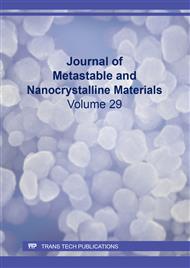[1]
Maninder Singh, Khushdeep Goyal and Deepak Kumar Goyal, Fabrication and performance of aluminium based metal matrix composites with SiO2 and TiO2 as reinforced particles, Universal Journal of Mechanical Engineering, 3(4), (2015), 142-146.
DOI: 10.13189/ujme.2015.030404
Google Scholar
[2]
S. Nallusamy and N. Manikanda Prabu, Design and development of a metal matrix composite for aeronautical applications-An assessment, International Journal of Research in Mechanical, Mechatronics and Automobile Engineering, 1(4), (2016), 148-155.
Google Scholar
[3]
S. Nallusamy, Synthesis and characterization of carbon black- halloysite nanotube hybrid composites using XRD and SEM, Journal of Nano Research, 45, (2017), 208-217.
DOI: 10.4028/www.scientific.net/jnanor.45.208
Google Scholar
[4]
A. Karthikeyan and S. Nallusamy, Experimental analysis on sliding wear behaviour of aluminium-6063 with SiC particulate composites, International Journal of Engineering Research in Africa, 31, (2017), 36-43.
DOI: 10.4028/www.scientific.net/jera.31.36
Google Scholar
[5]
Susanta K. Pradhan, Subhranshu Chatterjee, Amitava Basu Mallick and Debdulal Das, A simple stir casting technique for the preparation of in situ Fe-aluminides reinforced Al-matrix composites, Recent Trends in Engineering and Material Sciences, (2016).
DOI: 10.1016/j.pisc.2016.06.011
Google Scholar
[6]
S. Nallusamy and A. Karthikeyan, Analysis of wear resistance, cracks and frictional properties of metal matrix composites with SiC additives and Al2O3 as reinforcement, Indian Journal of Science and Technology, 9(35), (2016), 01-06.
DOI: 10.17485/ijst/2016/v9i35/100149
Google Scholar
[7]
S. Nallusamy and A. Karthikeyan, Synthesis and wear characterization of reinforced glass fiber polymer composites with epoxy resin using granite powder, Journal of Nano Research, 49, (2017), 01-09.
DOI: 10.4028/www.scientific.net/jnanor.49.1
Google Scholar
[8]
M.T. Sijo and K.R. Jayadevan, Analysis of stir cast aluminium silicon carbide metal matrix composite: A comprehensive review, Procedia Technology, 24, (2016), 379-385.
DOI: 10.1016/j.protcy.2016.05.052
Google Scholar
[9]
S. Nallusamy and Gautam Majumdar, Effect of stacking sequence and hybridization on mechanical properties of jute-glass fiber composites, International Journal of Performability Engineering, 12(3), (2016), 229-239.
Google Scholar
[10]
I. Dinaharan, Influence of ceramic particulate type on microstructure and tensile strength of aluminum matrix composites produced using friction stir processing, Journal of Asian Ceramic Societies, 4(2), (2016), 209-218.
DOI: 10.1016/j.jascer.2016.04.002
Google Scholar
[11]
S. Nallusamy, A proposed model for sustaining quality assurance using TQM practices in small and medium scale industries, Int. Journal of Engg. Res. in Africa, 22, (2016), 184-190.
DOI: 10.4028/www.scientific.net/jera.22.184
Google Scholar
[12]
S. Nallusamy, A review on the effects of casting quality, microstructure and mechanical properties of cast Al-Si-0. 3Mg alloy, International Journal of Performability Engineering, 12(2), (2016), 143-154.
Google Scholar
[13]
S. Nallusamy, Analysis of MRR and TWR on OHNS die steel with different electrodes using electrical discharge machining, International Journal of Engineering Research in Africa, 22, (2016), 112-120.
DOI: 10.4028/www.scientific.net/jera.22.112
Google Scholar
[14]
Kangle Tian et al, Effects of in situ generated ZrB2 nano-particles on microstructure and tensile properties of 2024Al matrix composites, J. of Alloys and Comp. 594, (2014), 01-06.
DOI: 10.1016/j.jallcom.2014.01.117
Google Scholar
[15]
S. Nallusamy, Thermal conductivity analysis and characterization of copper oxide nanofluids through different techniques, Journal of Nano Research, 40, (2016), 105-112.
DOI: 10.4028/www.scientific.net/jnanor.40.105
Google Scholar
[16]
Shisheng Li et al, Enhanced mechanical behaviour and fabrication of silicon carbide particles covered by in-situ carbon nanotube reinforced 6061 aluminium matrix composites, Materials and Design, 107, (2016), 130-138.
DOI: 10.1016/j.matdes.2016.06.021
Google Scholar
[17]
S. Nallusamy, Characterization of epoxy composites with TiO2 additives and E-glass fibers as reinforcement agent, Journal of Nano Research, 40, (2016), 99-104.
DOI: 10.4028/www.scientific.net/jnanor.40.99
Google Scholar
[18]
M.T. Sijo and K.R. Jayadevan, Fabrication of aluminium matrix composites reinforced with nano- to micrometer-sized SiC particles, Materials and Design, 89, (2016), 58-70.
DOI: 10.1016/j.matdes.2015.09.130
Google Scholar
[19]
S. Nallusamy, Analysis of welding properties in FSW aluminium 6351 alloy plates added with silicon carbide particles, International Journal of Engineering Research in Africa, 21, (2015), 110-117.
DOI: 10.4028/www.scientific.net/jera.21.110
Google Scholar
[20]
LinlinYuan, JingtaoHan, JingLiu and ZhengyiJiang, Mechanical properties and tribological behaviour of aluminium matrix composites reinforced with in-situ AlB2 particles, Tribology International, 98, (2016), 41-47.
DOI: 10.1016/j.triboint.2016.01.046
Google Scholar
[21]
Nallusamy S and Manoj Babu, X-Ray differaction and FESEM analysis for mixture of hybrid nano particles in heat transfer applications, Journal of Nano Research, 37, (2015), 58-67.
DOI: 10.4028/www.scientific.net/jnanor.37.58
Google Scholar
[22]
Sergey Lurie et al, Multiscale modelling of aluminium-based metal–matrix composites with oxide nano inclusions, Computational Materials Science, 116, (2016), 62-73.
DOI: 10.1016/j.commatsci.2015.12.034
Google Scholar
[23]
S. Nallusamy, A. Manoj Babu and N. Manikanda Prabu, Investigation on carbon nanotubes over review on other heat transfer nano fluids, International Journal of Applied Engineering Research, 10(62), (2015), 112- 117.
Google Scholar
[24]
R. Suganthini Rekha, S. Nallusamy, R. Vijayakumar and S. Saravanan, Modeling and analysis of crank shaft with metal matrix composites, International Journal of Applied Engineering Research, 10(62), (2015), 133- 137.
Google Scholar
[25]
S. Nallusamy, Enhancement of productivity and efficiency of CNC machines in a small scale industry using total productive maintenance, International Journal of Engineering Research in Africa, 25, (2016), 119-126.
DOI: 10.4028/www.scientific.net/jera.25.119
Google Scholar


